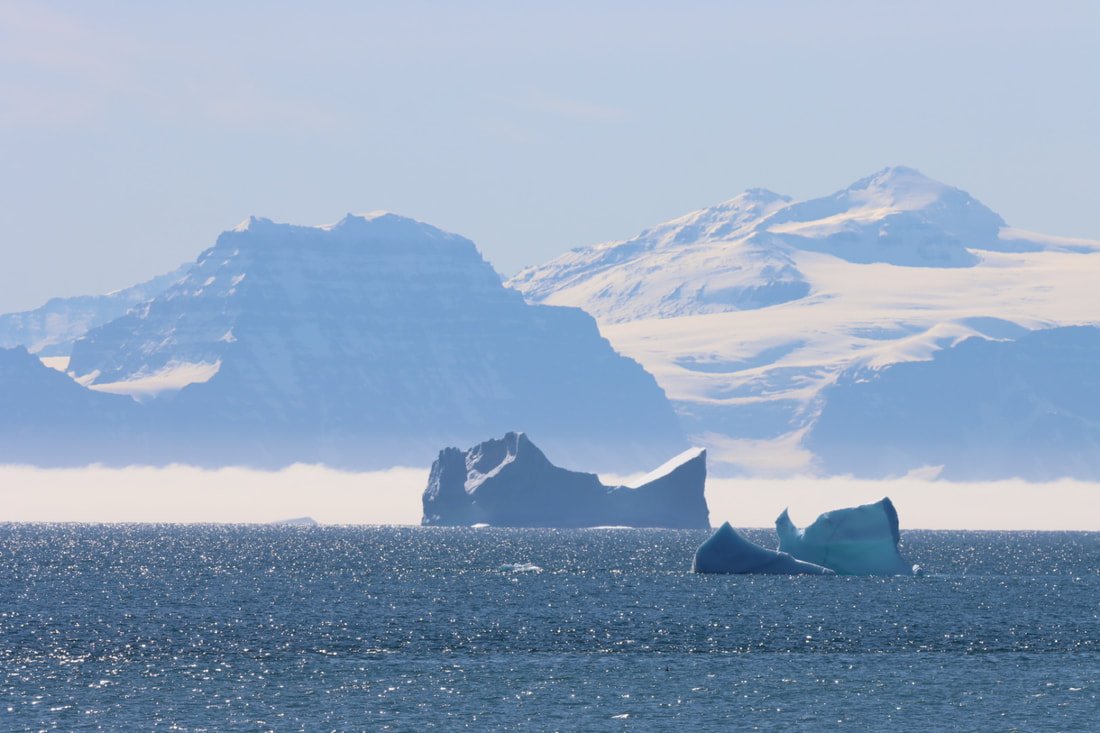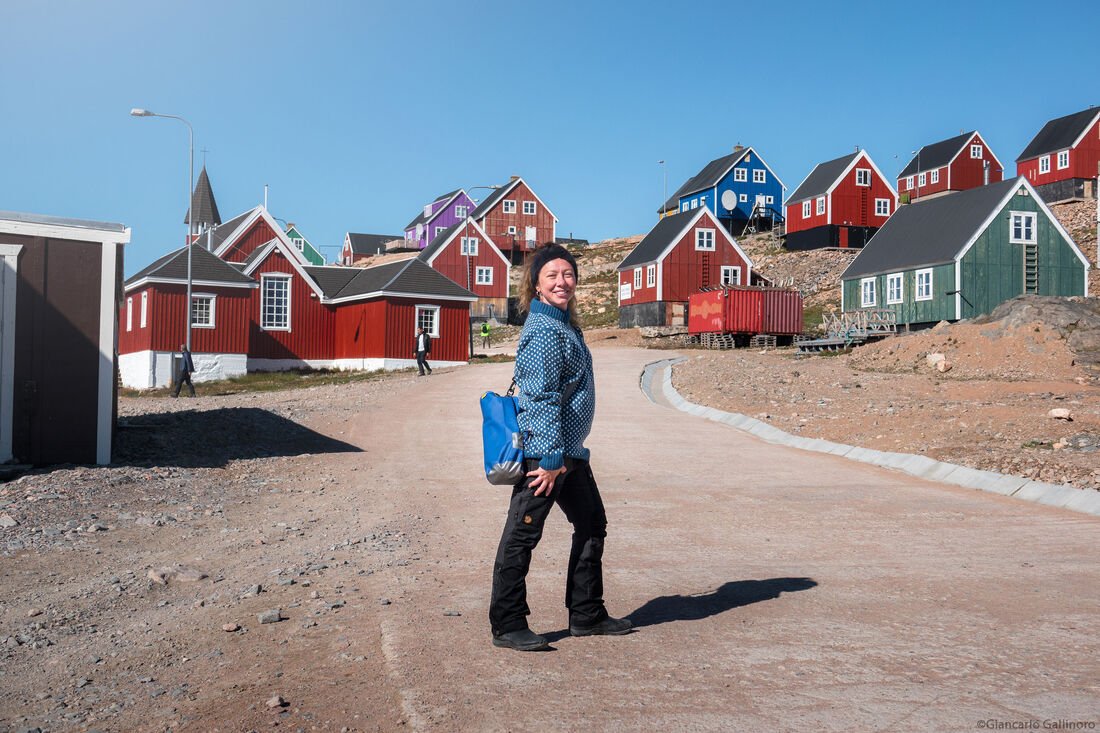10 Best Tips and Tricks For Your Arctic Cruise
Angela DiLanzo (top right) visited Sky Lagoon in Iceland during her Arctic cruise with Atlas Ocean Voyages. (Photo courtesy of Angela DiLanzo)
A cruise to the remote Arctic regions of the world ranks as a true "bucket list" travel experience, and it provides the opportunities to get up close and personal with some of the most breathtaking landscapes, unique wildlife and isolated small towns at the top of the world.
After two Antarctic expeditions with Atlas Ocean Voyages in 2021 (and some pretty irresistible incentives to return onboard), I leapt at the opportunity to explore the opposite pole with this expedition cruise line. I joined Atlas' voyage from Longyearbyen, Svalbard, Norway, to Edinburgh, Scotland, in summer 2022, with Arctic landings across Jan Mayen and Greenland, before navigating south of the Arctic Circle to Iceland, the Faroe Islands and Scotland.
The cruise line's new 196-passenger World Navigator ship offers the onboard experience you would expect from a luxury cruise ship. It features modern staterooms with comfy bedding and an unbelievable shower (seriously), tableside dinner service featuring new menus nightly, a fantastic spa, exceptional staff, plus the small ship size that provides an intimate space and on-board social activities for travelers and even crew to spark new friendships.
When you cruise the polar regions, you are not really on a "cruise" at all. You are on an expedition. While I was able to make use of much of the clothing I acquired for Antarctica, the overlaps ended there. The Arctic has an identity entirely its own.
Now that I have had a glimpse into the breadth of the Arctic, I know I will return. It's a diverse region with infinite offerings. I would encourage anyone to book their own expedition to the extreme north -- and to keep the following in mind when doing so.
Above, a reindeer grazes as World Navigator sits offshore. (Photo courtesy of Angela DiLanzo)
1. Jumpstart Your Stay with Extra Time in Norway
The best decision I made in the planning stages for this adventure was to tack on four extra days prior to departure in the small embarkation city of Longyearbyen in Svalbard.
Svalbard, also known as Spitsbergen, is a small archipelago located northwest of Scandinavia, at a latitude just over 78 degrees North, roughly 12 degrees north of the Arctic Circle -- way up there! While technically part of the Kingdom of Norway, Svalbard is a sovereignty, and this is integral to its magic.
When John Lennon sang the lyric "Imagine there's no country . . . ," I fancy that Svalbard embodies what he was picturing. While customs and immigration at Oslo Gardermoen Airport punched an exit stamp in my passport (Wait, isn't this a domestic flight?), there was no customs and immigration processing at all in Svalbard Airport. Svalbard has open borders for anyone whose nations are registered signatories of the Svalbard Treaty, so you only need to make it past the large taxidermy polar bear mounted above the baggage carousel, instead.
Because of the open-door policy, I encountered year-round and seasonal transplants from countries of origin as diverse as France, Mexico, England, the Philippines, Vietnam, Norway, Italy, Canada, Colombia and Russia. All of these people relocated to live out their passion for the Arctic. This blissful melting pot is the outcome when people aren't encumbered by country or boundary and are allowed to follow their hearts.
Residents advised me that my July visit was during the brief season without snow (though, to be honest, their sales pitches for an April return are incredibly enticing). There are a number of excursions available from Longyearbyen to introduce you to the region, from more commonplace outdoorsy experiences including ATV rides and kayaking among fjords, which aim to get you closer to the scenery while having a bit of fun, to day cruises to the abandoned Soviet coal-mining town of Pyramiden. You could also check out the research community and northernmost "city" on the globe, Ny Alesund (also a popular landing for cruises circumnavigating Svalbard) or go Arctic fox spotting with See & Explore. My personal favorite was dinner at Camp Barentz.
Enjoying some ATV time pre-cruise in Norway. (Photo courtesy of Angela DiLanzo)
The camp is a cabin outside of town with reindeer (and vegetarian) stews cooked over campfire, then served while our host gave an impressive talk about polar bears, complete with her own up-close-and-personal encounters.
There are also two small museums. The Svalbard Museum showcases taxidermy of every regional critter, big and small, alongside exhibits on the flora, fauna, history and culture of Svalbard. The North Pole Expedition Museum displays the stories and memorabilia from early attempts to reach the geographic North Pole, including Roald Amundsen's celebrated first completed journey aboard the Norge airship and the later tragedy that followed for the Norge's designer, Umberto Nobile, and Amundsen himself. Allot one to two hours per museum visit.
You also might want to consider other pre- or post-cruise stays in Tromso or Lofoten, Norway, or other Arctic towns specific to your cruise's embarkation point. I disembarked World Navigator in Edinburgh, Scotland.
You might be lucky enough to spot a polar bear on your Arctic cruise. (Photo courtesy of Angela DiLanzo)
2. Look for Wildlife, and Maybe Snag ‘The Big Five’
Much like African safaris have a "Big Five" list of animals, Arctic cruises have their list, as wildlife viewing is one of the most exhilarating activities in this part of the world. Because there is no formal list, I have gone ahead and designated the polar bear, Arctic fox, walrus, reindeer and puffin as the favored animals to spot, based on my own informal census.
Reindeer will be your easiest "get," as it's the most abundant and people-friendly animal of my Big Five.
Reindeer, puffins and walruses are among the animals you'll be on the lookout for during your cruise in the Arctic. (Photo courtesy of Angela DiLanzo)
During my stay, I caught over a dozen grazing throughout Longyearbyen, sometimes only meters from the roads. A large herd also welcomed us at our landing in Trygghamna, Svalbard. Depending on your cruise route, spotting walruses might also be likely, as they live in colonies with known whereabouts. Polar bear and Arctic fox sightings come down more to luck than anything else, though trackers and even gossip among residents could bring you into contact, another reason to arrive early and book excursions. In the days prior to my arrival in Longyearbyen, a polar bear had broken into the staff dormitory housing at Pyramiden, and several groups had seen the polar bear in that area. Lo and behold, the day cruise that I booked to Pyramiden also encountered him down the coast leading toward town. Granted, cruisers on Atlas Ocean Voyages' prior departure, which circumnavigated Svalbard mid-July, came upon seven bears (lucky duckies!) and a big fat zero were seen on mine. You never know.
Keep a sharp eye out for puffins on your Arctic journey. (Photo courtesy of Angela DiLanzo)
We had a number of puffin sightings. However, puffin season is limited to the summer months and sightings should not be expected in other seasons. Seabirds were the most prevalent of all Arctic animals, so while the puffin might be the most popular, birders will rejoice at the abundance of black guillemot, rock ptarmigan, barnacle geese and the incredible Arctic tern, which migrates about 25,000 miles from pole to pole, each year.
I also spotted a ringed seal and several whale species, though they were often a blip on the watery horizon. Atlas' expedition leader Katya Uryupova also informed that cruises with routes through the Canadian or Russian Arctic regions may also come upon musk oxen. And while not technically wildlife, the many sled dogs encountered both in Svalbard and Greenland had my fellow cruisers thoroughly smitten.
The blue lupine blooming from the terrain is especially enchanting. (Photo courtesy of Angela DiLanzo)
3. Arctic Flora is Also Impressive
You'll have so much overwhelming the senses from every direction, but remember to look down, too. The Arctic is made up primarily of permafrost, a layer of frozen earth that appears in the summer months once the snow melts away. While it might look lush from a distance, the permafrost in these regions are almost exclusively a delicate blanket of moss and lichen. Jan Mayen's moss layer is so thick, one misstep would result in you being sunk up to your knees.
Arctic cotton plants are whimsical tufts springing from the tundra. They resemble the cloud-like seed phase of a dandelion, but soft and thick like an actual cotton ball, little ghosts throughout the green.
The farther south we voyaged, the more blooms we encountered. Arctic poppy, so full of warm hues, also begins to appear. The beautiful blue-violet lupine greeted us on the island of Heimaey, Iceland. Legend tells that after the 1973 volcanic eruption, residents intentionally scattered thousands of lupine seeds onto the disrupted earth, so its strong, winding roots would stabilize the ground and serve as a colonizer plant species so growth could return.
You'll have an amazing opportunity to capture stunning landscapes as well as fascinating creatures throughout the region. (Photo courtesy of Angela DiLanzo)
4. Flex Your Photography Skills While Traveling
Of course, capturing your travel memories is a given on any vacation, but photography in the Arctic regions comes with unique challenges. While smartphone cameras have come a long way, it would be worth the investment to upgrade your equipment and practice shooting to ensure you get some great snaps.
Wildlife photography is not so simple. Reindeer might keep their distance, but it is going to be absolutely impossible to get up close to a polar bear. Guides even carry rifles to ensure the bears don't get too close (and if you do end up precariously close to a Polar bear, perhaps photography shouldn't be your first concern). Expedition photographer Giancarlo Gallinoro, who specializes in nature photography and has spent four years in the Arctic regions shooting wildlife, suggests procuring a 600mm zoom lens to bridge the expected distance between you and much of the wildlife here.
Distance from wildlife is not the only challenge. The unusual bullet-like flight speeds and patterns of puffin and other seabirds are stress-inducing. Gallinoro suggests a high-speed auto-focus on your DSLR or mirrorless camera to keep up. Also, heavy fogs and the Arctic sheen that obscures the horizon is not for the fainthearted amateur. So practice, practice, practice. Gallinoro advises taking the leap from full auto to manual shooting, if you really hope to get your best, clearest shot.
When it comes to sea mammals, the challenges are that these creatures are often underwater with only a fraction of their back periodically surfacing. Gallinoro says that cruise ships are often not the best place to shoot, as the size of the ship often creates proximity issues, though the 600mm lens is best if you do have a sighting. To get closer, he advises booking whale-watching excursions or day cruises on small boats at the landing destinations.
A group of my fellow cruisers did exactly this, booking a whale-watching tour in Isafjordur, Iceland. When they encountered a pod of whales, they utilized a fun photo hack of their own; they had their smartphone cameras on video while a pod of belugas bobbed in the sea behind them. You can then get a pretty good screen grab to create a photo when the whale emerges in your shot.
For drone fans, Gallinoro warns that the AECO (Association of Arctic Expedition Cruise Operators) prohibits drone use in the Arctic, but some vessels or local providers might allow it, so double check prior to booking, if using your drone onboard is important. As a member of AECO, drone usage is not permitted onboard World Navigator. (Drone permissions also vary by destination, regardless of AECO rules, so research every landing site if you do intend to bring a drone to the Arctic).
In The Loop Travel correspondent Angela DiLanzo poses for a shot — thanks to the expedition photographer — in Ittoqqortoormiit, Greenland. (Photo courtesy of Giancarlo Gallinoro)
5. Get to Know the Cruise Expedition Team
Polar cruises are led by expedition teams, so expect to encounter marine biologists, ornithologists, meteorologists, mountaineers and more performing double duty as your onboard guide team. While some team members gave full lectures relating to their various expertise (which definitely enhanced the onboard experience), all of them have extensive experience at the polar regions. Sharing dinner or chatting in the lounge with any one of them is guaranteed to deliver a mind-blowing conversation.
Our team on World Navigator included three individuals who lived and worked at various Antarctic research bases, two who had called Svalbard home over several years, and a few with PhDs in related sciences. With decades of cumulative guiding experience throughout both the polar regions and Earth's wildest natural environments, we were in good hands but also fascinating company.
6. Be Ready for Adventure in the Arctic
When cruising the polar seas, there typically aren't formal places to dock. In Antarctica, you will never dock, and many Arctic landings are the same. Landing spots constantly change because of snowfall and melt-off. They also might be completely inaccessible because of seasonal or daily weather conditions. With these destinations being so remote, expedition cruise ships often remain positioned at sea while the expedition team escorts us to land or for exploratory scenic cruises in small, motorized rubber boats called Zodiacs. Not only can the Zodiacs land ashore, they can zip up close to glaciers and fjords, icebergs and even sea life and sea birds.
Weather permitting, adventure sports including kayaking and stand-up paddleboarding are also offered on these cruises. This means you can flex your adventure muscles while also immersing yourself in the stillness of your environment.
Don’t miss the adorably fluffy highland cows in the Faroe Islands. (Photo courtesy of Angela DiLanzo)
7. Find Extra Activities that Interest You
The truth is that no one knows your preferences better than you, so review your itinerary ahead of time and see which landings are in towns. While Atlas Ocean Voyages offered several excursions or adventures in these destinations (and I did an ATV ride up to the volcano in Heimaey, Iceland), it helps to be prepared to maximize the relatively brief stays you have in certain locations.
In addition to Atlas' offerings, I tacked on two excursions independently with some of my fellow cruisers. These were shore excursions that we sourced ourselves. It was clear we would never have time to do it all in Reykjavik, Iceland, so I relaxed with a number of fellow cruisers at Sky Lagoon, a hot springs attraction that is not nearly as famous as the Blue Lagoon but closer to the city center with a swim-up bar for wine and "The Ritual" facial — which touts the ability to strip 30 years off your skin.
I joined friend Darla Baird, who sourced a full-day private van tour of the Faroe Islands, along with four other cruisers. Our driver, Johan Hojgaard, drove us to every nook and cranny of the islands, including an array of waterfalls, overlooks and grass-roofed houses. He also introduced us to a couple "highland coos" -- I mean cows.
Katya Uryupova advised that there are a number of exciting options that could upgrade your trip. She suggests researching horseback riding in Iceland, gourmet tours, bird-watching and cycling or hiking tours throughout the Arctic. When sneaking away from the ship on a private excursion, it is always important to mind your timings and research where your activity is in relation to the port.
The Faroe Islands are a scenic stunner. (Photo courtesy of Angela DiLanzo)
8. Behold the Midnight Sun (Seasonal)
The Arctic offers the one thing you won't find elsewhere in the world: 24 hours of round-the-clock daylight in the high summer months (and, conversely, 24 hours of darkness in the winter, though Arctic cruises are not offered during the dark months. So, for those truly interested, this season is only available to experience through land-based destination travel). Even in Antarctica, cruise ships themselves can't sail far enough south to entirely rid the night of a brief sliver of darkness.
I will confess that constant daylight is disorienting. It is strange when 10 p.m. suddenly feels like the correct time to eat dinner, despite the World Navigator's dinner schedule, and there was that night or two where the bar in the Dome Lounge closed and shooed us off to bed, leaving us bewildered that we had truly drank and danced the night away. A good sleep mask should be a packing requisite for an Arctic voyage, and thankfully the ship had good blackout curtains.
Despite being disoriented, the infinite daylight was a reminder we were somewhere else. There aren't many moments of pure wonder, but the sky alone transports you with its unyielding brightness.
Several of my cruise mates hoped for a glimpse at the Northern Lights, as well, but you can't have both the Midnight Sun and the Lights. While viewing the ebb and flow of the aurora sashaying across the sky is a bucket-list must, expectations should align with your particular cruising season.
"The most important thing is that you travel when there are proper dark nights!," Uryupova says. "Starting from mid-August (the earliest!) but better in September, you have a good chance to witness this weather phenomenon.
"Everything above the Arctic Circle, including Norway, Russia, the U.S. state of Alaska, Canada, Finland, Sweden, Greenland and even nearby Iceland" are great places to possibly encounter the Lights.
She also suggests cruise travel over land travel because: "The advantage of sailing on a cruise ship is that you are constantly in motion. If you have a weather front and cloudy weather . . . or overcast (sky) on land, you can't change the situation and you just wait for better weather.
"The opposite situation, when you are on board a ship, then you have a better chance to find a location with clear skies, which is very important for seeing Northern Lights."
While 24 hours of daylight are guaranteed seasonally, the Northern Lights do require a certain amount of good luck, so hedge your bets and pick dates that align with your preference.
9. Sample the Regional Cuisine
So, you want to view the wildlife, of course. But are you ready to eat it? You will find reindeer steaks, burgers and other concoctions on a number of menus. Minke whale, with a veal-like texture and a gamey taste, was occasionally on offer in Svalbard and Iceland, where whaling is legal, and you also might find puffin dishes in Iceland.
Adventurous eating is always an option, but there is plenty of standard fare, as well, including diverse seafood options (and some really good pizza, for the especially timid). Beer drinkers will find themselves in heaven, as each town seems to have its own brewery (or two or three), with plenty of original brews on tap.
"Arctic brownies" were served after several meals, and while brownies are accessible throughout the globe, there is something extra good about the regional chocolate. So, whether it's a brownie or a couple chocolate bars, save room and indulge your sweet tooth.
One of the fun (we swear!) activities you can try on an Arctic cruise is the polar plunge. Join the adventure by diving into the region’s icy waters. It's a refreshing blast. Would you dare? (Photo courtesy of Giancarlo Gallinoro)
10. Polar Plunge!
For the uninitiated, a polar plunge is exactly what it sounds like: a swan dive (or cannonball, or bellyflop) into the icy-cold waters of the polar areas. Most expedition cruise ships host a once-per-voyage opportunity to jump off the side of the ship into the frigid and remote waters are navigating.
Sure, it sounds terrible, and you should always be wary of any personal health risks, but having completed two in the South Seas and my latest one off the shores of Greenland, the less than 10 seconds actually spent in the water is made worth it with the big, cozy towel, shot of tequila and big cup of hot chocolate you are greeted with once you return onboard.
This is definitely a fun tick for your bucket list, and polar plunging in both the Arctic AND Antarctica will provide you with ultimate travel cred! I think it can best be summed up with "YOLO!"
Thanks for reading, and we hope this has you excited for your expedition cruise in the Arctic.
An amazing scene in the Faroe Islands. (Photo courtesy of Angela DiLanzo)













